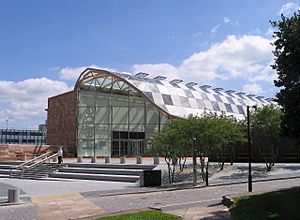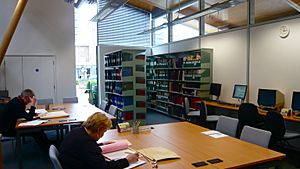Herbert Art Gallery and Museum facts for kids

Herbert Art Gallery & Museum from Cathedral Square
|
|
| Established | 1960 |
|---|---|
| Location | Jordan Well, Coventry, England |
| Visitors | >1 million between 2008 and 2011 |
| Public transit access | Pool Meadow Bus Station |
The Herbert Art Gallery & Museum, often called just The Herbert, is a cool place in Coventry, England. It's not just an art gallery; it's also a museum, a place to find old records, a learning center, and a creative space!
Contents
Discover The Herbert Museum
The museum is named after Sir Alfred Herbert. He was a rich businessman from Coventry who loved to help others. He gave a lot of money to build the museum, which first opened in 1960. Building started in 1939 but paused because of the Second World War.
In 2008, The Herbert got a big makeover that cost £14 million. It became even better!
The Herbert is run by a group called Culture Coventry, which is a charity. This means it's free to visit! The museum gets money from donations, its shop, and by renting out parts of the building for events. In 2010, over 300,000 people visited, making it super popular in the West Midlands.
A Look Back: History of The Herbert
Before The Herbert, Coventry had smaller museums. But the city's art and museum items were spread out. So, the city council bought land over many years. In 1938, Sir Alfred Herbert gave £100,000 to build a new gallery and museum. Building started the next year.
During the Coventry Blitz in World War II, much of the city was destroyed. Construction on the museum stopped, with only the basement finished. After the war, new plans were made in 1952. Sir Alfred Herbert gave another £100,000! He passed away in 1957, but the museum, named after him, opened on March 9, 1960. His wife, Lady Herbert, officially opened it.
Modern Makeover: 2005–2008
The museum had a big update in two parts. The first part finished in 2005. During this time, a huge painting by a 17th-century artist named Luca Giordano was too big to move. It was covered up for three years and then uncovered just in time for the reopening!
The second part of the makeover finished in early 2008, costing £14 million. They added a new entrance and a large glass-covered area. The updated museum now has a cafe, learning spaces, more galleries for special shows, and places to keep old city records safe.
Culture Coventry: More Than Just The Herbert
The Herbert is part of Culture Coventry. This group also looks after three other cool historical places nearby:
- Coventry Transport Museum: This museum is full of British-made cars, motorcycles, and bicycles. Coventry used to be a big center for making cars!
- Lunt Roman Fort: About three miles from Coventry, you can see a rebuilt part of an old Roman fort from AD 60.
- The Old Grammar School: This is a very old and important building in Coventry.
The Herbert won the Guardian Family Friendly Award in 2010. It was also nominated for the Art Fund Prize for being great at getting new people interested in art.
Amazing Collections at The Herbert
The Herbert has lots of different things to see! You can explore galleries with sculptures, old paintings by famous artists, art from the 1900s, local history, and even natural history (called Elements).
One special collection is costumes, from around 1800 to today. It focuses on women's clothes from the 1800s. The museum is now collecting more modern clothes and items from different cultures in Coventry.
Another cool collection shows Coventry's history of making ribbons. It includes over 250 sample books and special silk pictures called Stevengraphs. These show how important ribbon making was to the city.
In 2011, the museum raised £12,000 to buy "The Coventry Album." This album has paintings from 1819 by William Henry Brooke. It's one of the most important collections of old pictures of Coventry.
Coventry Archives: City's Memory Bank
The Coventry Archives is located inside The Herbert. It holds the biggest collection of records and history related to Coventry. It's like a giant memory bank for the city!
In 2018, the Coventry Archives got a new name. Before that, it was known as the Coventry History Centre.
Cool Exhibitions and Projects
The Herbert often has special shows and projects. In 2005, they had a theatre project for kids. It showed them what it was like to be a child evacuated during the 1940s war. This event won two awards!
The museum has four spaces for temporary exhibitions. These shows come from famous places like The British Museum and the Natural History Museum. The Herbert also creates its own shows about local history and people's lives.
In 2009, the Herbert showed 50 beautiful watercolour paintings by British artists like J. M. W. Turner.
To celebrate its 50th birthday in 2010, The Herbert had many events. Over 1,000 people came to a special event in March. They saw ten important objects, including a 16th-century tapestry and Shakespeare's ring, which showed the history of Warwickshire.
In 2018, The Herbert hosted two big exhibitions:
- PLAY: This show was made with a video game company called Rare. It explored the history of their games and different ways humans play. Visitors loved how interactive and fun it was!
- ARTIST ROOMS: Anselm Kiefer: This exhibition featured works by a famous German artist, Anselm Kiefer. His art often explores ideas about national identity and memory.
In 2020, The Herbert worked with Coventry University on a project about the author George Eliot. Students got to explore museum items and archives related to her life and work. They even made films about her! This project is now part of the university's English degrees, so more students can learn this way.





